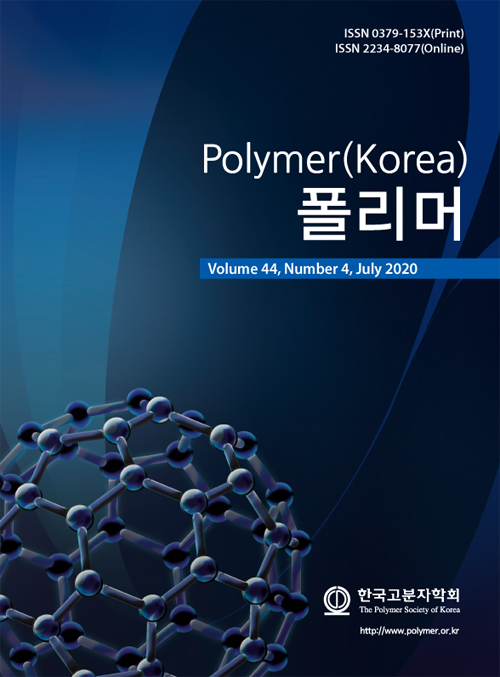- Effect of Surface Modified Cellulose Nanocrystal Fillers on the Mechanical Properties of Thiol-ene Photopolymerized Nanocomposites Using Diallyl Ether Monomer
Department of Chemical Engineering, Keimyung University, Daegu 42601, Korea
- 표면 개질된 셀룰로오스 나노 결정 충전제가 디알릴 에테르 단량체를 사용한 Thiol-ene 광중합 나노복합체의 기계적 물성에 미치는 영향
계명대학교 공과대학 화학공학과
In this study, thiol groups
were introduced on the surface of cellulose nanocrystal (CNC) using
(3-mercaptopropyl)trimethoxysilane (MPTS). We prepared nanocomposites using
pristine CNC and MPTS-modified CNC (CNC-MPTS) as nanofillers and undergoing
thiol-ene photopolymerization in trimethylolpropane tris(3-mercaptopropionate)
(TMPTMP) and trimethylolpropane
diallyl ether (TMPAE). By comparing the modulus and glass transition temperature (Tg)
of nanocomposites with 5.0 wt% pristine CNC and the CNC-MPTS nanofillers to UV
cured resin without filler, this study confirmed an increase in modulus by 1.31
and 1.59 times, and increase in Tg by 1.3 and 1.8 oC
by universal testing machine (UTM) and dynamic mechanical analyzer (DMA), respectively.
본 연구에서는
(3-mercaptopropyl)trimethoxysilane(MPTS)를 사용하여
cellulose nanocrystal(CNC) 표면에 티올기(-SH)를 도입하였다. 순수 CNC와 MPTS로
개질된 CNC(CNC-MPTS)를 나노충전제로 사용하여 trimethylolpropane
tris(3-mercaptopropionate)(TMPTMP)와 trimethylolpropane diallyl
ether(TMPAE)를 thiol-ene 광중합법으로 나노복합체를 제조하였다. 5.0 wt%의 순수 CNC 및 CNC-MPTS를 나노충전제로 사용한 나노복합체의 탄성률과 Tg를 순수 수지 중합체와 비교하면,
탄성률은 1.31 및 1.59배 증가하고, Tg는 1.3 및 1.8 oC 증가하는 것을 만능재료시험기(UTM) 및 동적기계분석기(DMA) 측정으로 각각 확인하였다.
Keywords: cellulose nanocrystal, (3-mercaptopropyl)trimethoxysilane, thiol-ene photopolymerization, mechanical property, nanocomposites
- Polymer(Korea) 폴리머
- Frequency : Bimonthly(odd)
ISSN 0379-153X(Print)
ISSN 2234-8077(Online)
Abbr. Polym. Korea - 2023 Impact Factor : 0.4
- Indexed in SCIE
 This Article
This Article
-
2020; 44(4): 579-588
Published online Jul 25, 2020
- 10.7317/pk.2020.44.4.579
- Received on May 25, 2020
- Revised on Jun 4, 2020
- Accepted on Jun 4, 2020
 Correspondence to
Correspondence to
- KiRyong Ha
-
Department of Chemical Engineering, Keimyung University, Daegu 42601, Korea
- E-mail: ha.kiryong@gmail.com










 Copyright(c) The Polymer Society of Korea. All right reserved.
Copyright(c) The Polymer Society of Korea. All right reserved.